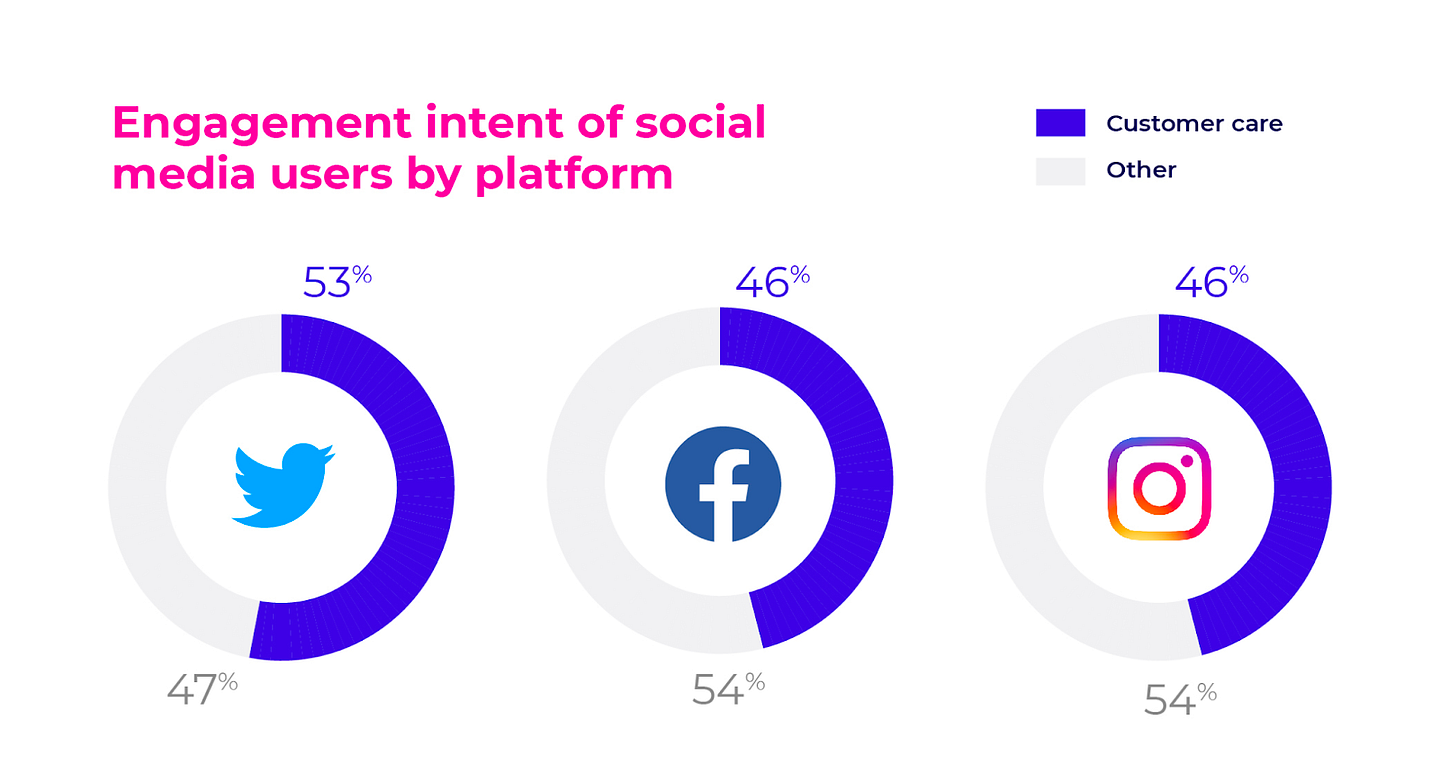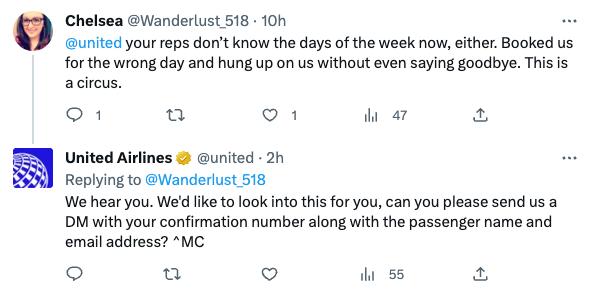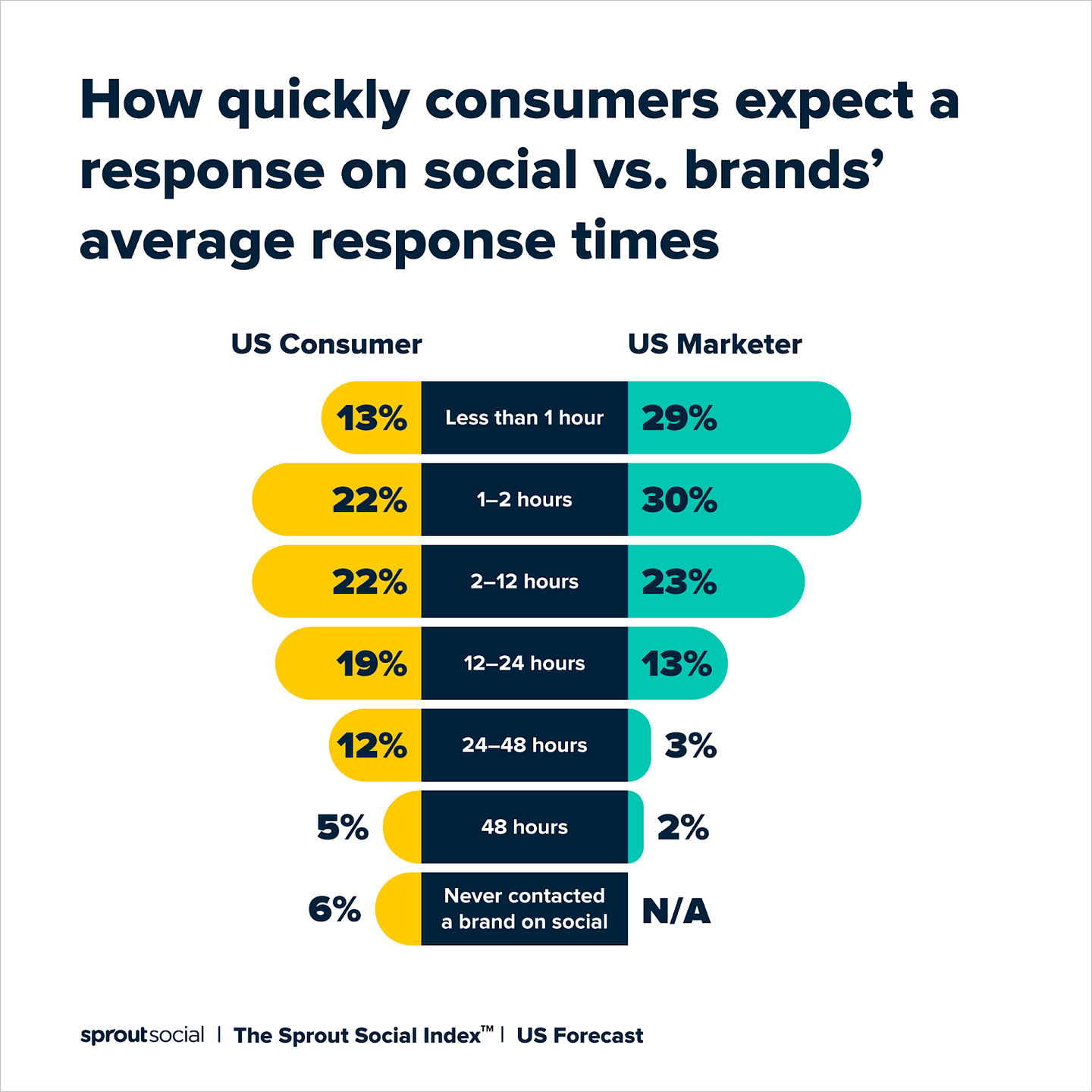Imagine sitting in a bustling airport when you suddenly receive the news that your flight will depart six hours late. Suddenly, the all-too-familiar dread of frustration fills the room. You desperately need to reach home for a cherished family event — your sister’s high school graduation.
The phone lines to the airline’s customer service are snarled and jammed. Your pleas for help are lost into a sea of automated responses and hold music. You start to think, is there any possible way out?
Then, an epiphany strikes! With a quick tap on your smartphone, you fire off a tweet — an SOS to the digital ether. And, to your disbelief (and much relief), a reply swiftly pings back. Suddenly, you’ve found yourself on the next flight to Boston. You’ve won the customer service lottery.
Welcome to the world of customer service on social media, where traditional phone lines and long wait times take a back seat. Even industries infamous for lacking customer service shine on this social media stage.
How? Offering prompt, efficient, and personalized solutions to their customers using social media platforms.
So, how can you master the art of customer service on social media? Let’s find out.
The rise of social media in customer service
In the past decade, we’ve witnessed an enormous shift in how businesses and customers interact. The biggest catalyst? The explosion of social media.
It’s no longer a question of whether businesses should be on social media, but how effectively they can use these platforms as open lines of communication with their customers.
From 2020 to 2021 alone, there was a staggering 110% increase in the number of consumers who preferred using social messaging for customer service inquiries. And that’s just one data point from dozens of others highlighting social media’s pivotal role in shaping the customer service landscape.
Don’t get us wrong. Traditional customer service methods, like phone calls, emails, and live chats with customer service representatives, are still in play. But they’re no longer the only players in town.
In fact, we’ve seen a significant pivot towards social media platforms, with 80% of US consumers sending customer service requests via social media. And of those requests, 84% received a response from the brand.
What does that tell us? This shift isn’t merely a fad but a response to today’s consumers’ changing needs and expectations of customer care.

Despite progress, the journey to excellent customer service on social media is far from complete. Shockingly, one-third of all customer complaints are still never answered. And, unsurprisingly, most of these neglected complaints originate on social platforms.
Unanswered complaints can decrease customer advocacy by as much as 50% while responding to a complaint can increase advocacy by up to 25%. Why?
Satisfied customers are more likely to become brand advocates. Sharing their positive experiences on social media and other platforms helps you generate quality leads.
And that’s why SaaS companies like Canva prioritize providing top-notch customer service, as it can significantly impact SaaS lead generation. Here’s a stellar example from a happy Canva customer:

On the flip side, lack of engagement can have far-reaching consequences, including an increased churn rate of 15% if companies choose not to respond to comments on social media.
These figures are a stark reminder of both the opportunities and the challenges in this new era of customer interaction. With that, it’s time to double down and master the art of customer service on social media to help your brand come out on top.
Best practices for customer service on social media
So what’s the secret sauce for customer service success on social media? Here are a few best practices to turn upset customers into brand advocates.
Active listening: continuously monitoring social media for customer feedback
Social media is a buzzing hive of information. Your customers are continuously sharing their experiences with your product or service. The result? A treasure trove of real-time feedback.
As your business unfolds its narrative on social media, lend an ear to your audience’s whispers and shouts.
- What are their concerns, their praises, and their suggestions?
- What are your customers saying about your brand?
- What threads are they weaving into your brand’s narrative?
But here’s the catch — are you actively listening to these voices?
Active social media listening goes beyond waiting for tagged mentions or direct messages from your customers. It’s a proactive approach to customer service interaction.
Think of it as scouring the expanse of social media platforms for any mention of your brand, products, or services — be it a bad experience or a positive one. Through active listening and social media listening tools, you can quickly identify direct complaints or customer questions, like United Airlines.

But this approach also helps you find the broader conversations, trends, and sentiments about your brand without them directly addressing you.
Remember, each tweet, post, or comment is a unique opportunity to engage, learn, and improve. If you tune into these signals with the help of social media listening tools, you can offer solutions, improvements, and personalized experiences that your customers will applaud.
Let’s take a look at another example in action. Clean Origin, known for its unique lab-grown diamonds, does an excellent job with active listening across the web. Not only are they paying close attention to what their customers are saying. They also use these comments to their advantage.
Here’s a look at a customer review that they’ve turned into a popular post on their Instagram.

By featuring real customer experiences and stories, they create an authentic and relatable connection with their audience. This approach enhances trust in the brand and creates a sense of community and belonging among happy customers.
The best part about customer satisfaction? These customers are more likely to share their positive experiences with their friends and family, organically spreading the word about your business.
As these recommendations circulate, more people become interested in your brand. Think of it as an indirect way to get free Instagram followers. And this surge in followers can significantly impact your business by increasing your online visibility and building loyal customers.
Responsiveness: providing timely and effective responses
Time is of the essence, particularly as a customer service rep handles customer queries or complaints on social media.
Why? Consumers are accustomed to the lightning speed of the internet and expect similar responsiveness from brands. In fact, a study by Sprout Social found that 76% of customers expect a response on social media within twenty-four hours.

Quick responses aren’t just a metric of efficiency. They’re a testament to your brand’s commitment to its customers.
Promptly addressing customer issues or acknowledging positive feedback makes it clear that you want your customers to feel valued. And that you aren’t wasting their time.
StudioSuits, a leading brand in the fashion industry, has demonstrated exceptional mastery in customer service on social media platforms. Their dedication to providing top-notch support and engagement with customers sets them apart and contributes to their success in building strong customer relationships.
Another way StudioSuits stands above the competition is through prompt responses on Facebook. In fact, their profile even shows that they are “very responsive” to messages.

Think of this as a badge of honor. Potential customers see this as a trust signal, knowing they can ask questions and seek a timely response before making a custom suit purchase.
But remember, speed isn’t everything. Your responses should be effective and relevant. It’s about being there for your customers when they need you, assuring them that help is just a tweet or post away.
Provide helpful solutions, not just automated, generic replies. Tailor your responses to the individual customer. And if you’re wondering how to conquer this task when you have hundreds of comments to reply to daily? Try embracing the power of an AI writer to help you streamline this process.
How? AI writers can write copy in more than ten different tones and dozens of languages, so you’ll be able to serve customers more quickly. And some AI copywriting tools, like Simplified, can assign messages to specific customer service agents and keep track of the responses.

With access to a social inbox feature where you can view all social media notifications and ongoing messages, it’s easier than ever to resolve conversations with customers within the 24-hour mark.
It’s a surefire way to provide exceptional customer service and boost customer loyalty.
Personalization: tailoring responses to individual customers
Have you ever received a reply from a brand that felt so cold and generic that it felt like they copied and pasted it from a pre-written customer service strategy handbook?
Well, that’s the exact feeling we aim to avoid. Customers today aren’t just seeking answers. They’re seeking validation. An assurance that they are seen, heard, and valued as unique individuals.
And the first step to providing this assurance is to treat their feedback not as just another ticket in your customer service queue but as a conversation with a valued individual.
Think of personalization as the secret ingredient in your customer service recipe. It’s the warmth in your response, the empathetic tone, and your efforts to remember past interactions and anticipate their needs.
So the next time you respond to a customer online, try addressing them by name. You might even acknowledge their emotions before crafting a solution that respects their unique context and needs.

By providing prompt and personalized responses on social media platforms, you showcase your commitment to making customers happy and establish yourself as a reliable industry leader.
Is it possible to manually comb through hundreds or even thousands of customer comments, complaints, and unhappy customer interactions? Probably not.
Thankfully, there are a few tools that should hold a key spot in your customer service toolbox. With the power of CRM software, you can increase your brand’s bird’s eye view to prevent those dreaded comments or complaints from slipping through the cracks.
Don’t underestimate the power of technology to help you centralize customer data, track conversations, and provide personalized support. Your customers will thank you. And so will your bottom line.
Transparency: handling mistakes and negative feedback openly
Mistakes happen. That’s a universal truth not just for humans but for brands, too.
Maybe an order was delayed in shipping. You sent an incorrect item. Or a service didn’t meet expectations. How you handle these slip-ups can significantly impact your brand’s reputation. Will you sweep it under the rug or own up and face it head-on?
Transparency calls for the latter approach. It’s about acknowledging your mistakes, apologizing sincerely, and openly communicating how you intend to rectify the issue. Yes, it’s a little uncomfortable. Yes, it may seem risky. But it’s the right thing to do.
Instead of disregarding, denying, or defending against negative comments, see them as an opportunity for improvement. Turn them into an avenue to demonstrate your commitment to customer satisfaction.
How? Respond promptly and respectfully. Apologize for any wrongdoing. Thank the customer for their feedback, and assure them that you’re working on the issue.

Use this as an opportunity to tell your customers, “We value your trust more than our image. We are here to learn and grow”.
There’s always an opportunity to turn negatives into positives and challenges into learning experiences. And within this process, you improve your customer service and enhance your brand’s authenticity, resilience, and reputation.
Proactivity: using social media for outreach and preventive customer service
What if you could proactively detect potential problems and resolve them head-on, preventing customer dissatisfaction? That’s where proactivity shines, turning traditional customer service teams into social media rockstars.
By actively monitoring your brand’s mentions, hashtags, and other social signals, you can catch and identify emerging issues and immediately nip them in the bud.
But proactive customer service isn’t limited to problem-solving. It also means:
- Promoting customer success rather than just handling customer complaints
- Sharing valuable content that enhances their experience with your brand
- Nurturing a dialogue that not only solves issues but prevents them
- Educating your target audience about your products or services
- Anticipating your customers’ needs
Let’s look at a brand that shines bright in this regard. Hims excels in customer service on social media by providing accurate and comprehensive information about the potential risks associated with over-the-counter Viagra, as well as other health issues men experience that is not discussed often, such as anxiety, mental health, and hair loss.

They understand the importance of empowering their audience with knowledge to make informed decisions about their health. Through engaging social media content and responsive interactions, Hims actively addresses concerns and questions, creating a supportive environment for their customers.

Through proactive direct messages, comments, and dedicated support channels, Hims makes sure that its audience receives personalized attention and guidance, fostering a sense of trust and confidence in their expertise.
Follow Hims’ lead and embrace proactivity to control the narrative around your brand. With this approach, social media becomes more than just a customer service channel — it becomes a tool for customer empowerment, engagement, and loyalty. Say hello to higher customer retention rates.
Wrapping up
The popularity of social media has changed customer service forever. Gone are the days of call centers and weeks in between email responses.
Mastering this new customer service approach to social media requires a whole new level of customer service skills — quick responses, personal touches, and social media listening tools.
Thankfully, customer service, it’s a journey, not a destination. It’s about always striving to improve, listening more carefully, and anticipating customer needs.
Each social media interaction isn’t just a chance to solve a problem. It’s an opportunity to strengthen your bond with your customers and improve their experience with your brand.
So, are you ready to use the power of social media to take your customer service to the next level?

